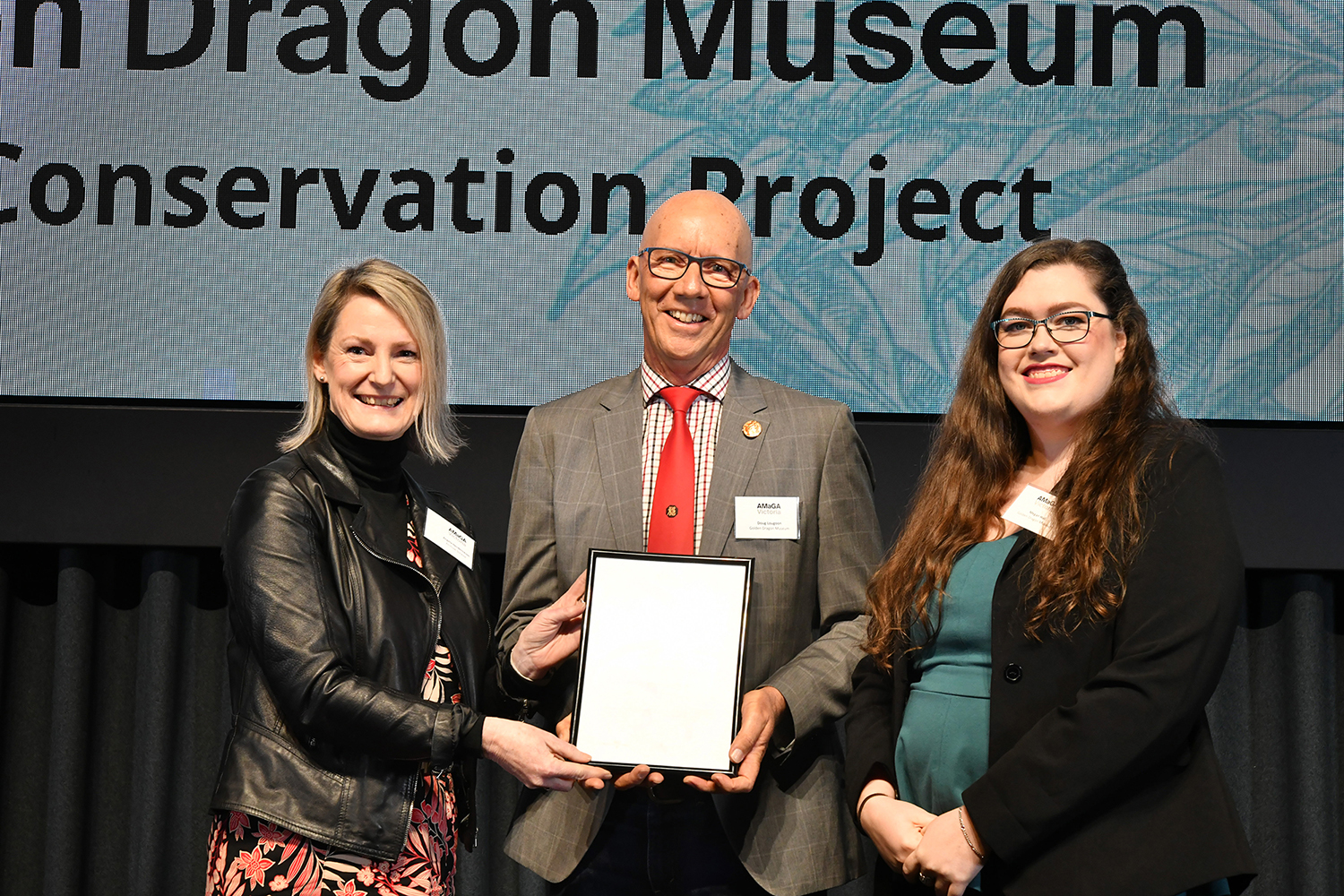Statement of Significance
In early 2021 Dr Sophie Couchman, an expert in Chinese Australian history and culture, was commissioned to undertake a Significance Assessment of the Golden Dragon Museum’s Collection. For the first time, the 30,000 or so objects in the Collection were considered and assessed, looking both at key individual pieces and the Collection as a whole.
Significance Assessments help museums to better understand their collections, their areas of strength and where they can best be further developed. A Significance Assessment is also invaluable for informing future exhibition programs as well as planning public and education programs. Significance Assessments are current often for years, even decades as they form an essential part of how a museum cares for, researches, develops and uses their most valuable asset; their collection.
Dr Couchman has described a Significance Assessment as ‘A reasoned, readable summary of the values, meaning and importance of a collection. It is more than a description of what the collection looks like. A Significance Assessment summarises how and why the collection is important. It is supported by research and evidence assembled through the assessment process.’ The Statement of Significance is the key findings of the Assessment and draws attention to the unique qualities of the Golden Dragon Museum’s Collection.
Following is Dr Couchman’s Statement of Significance of the Collection at the Golden Dragon Museum:
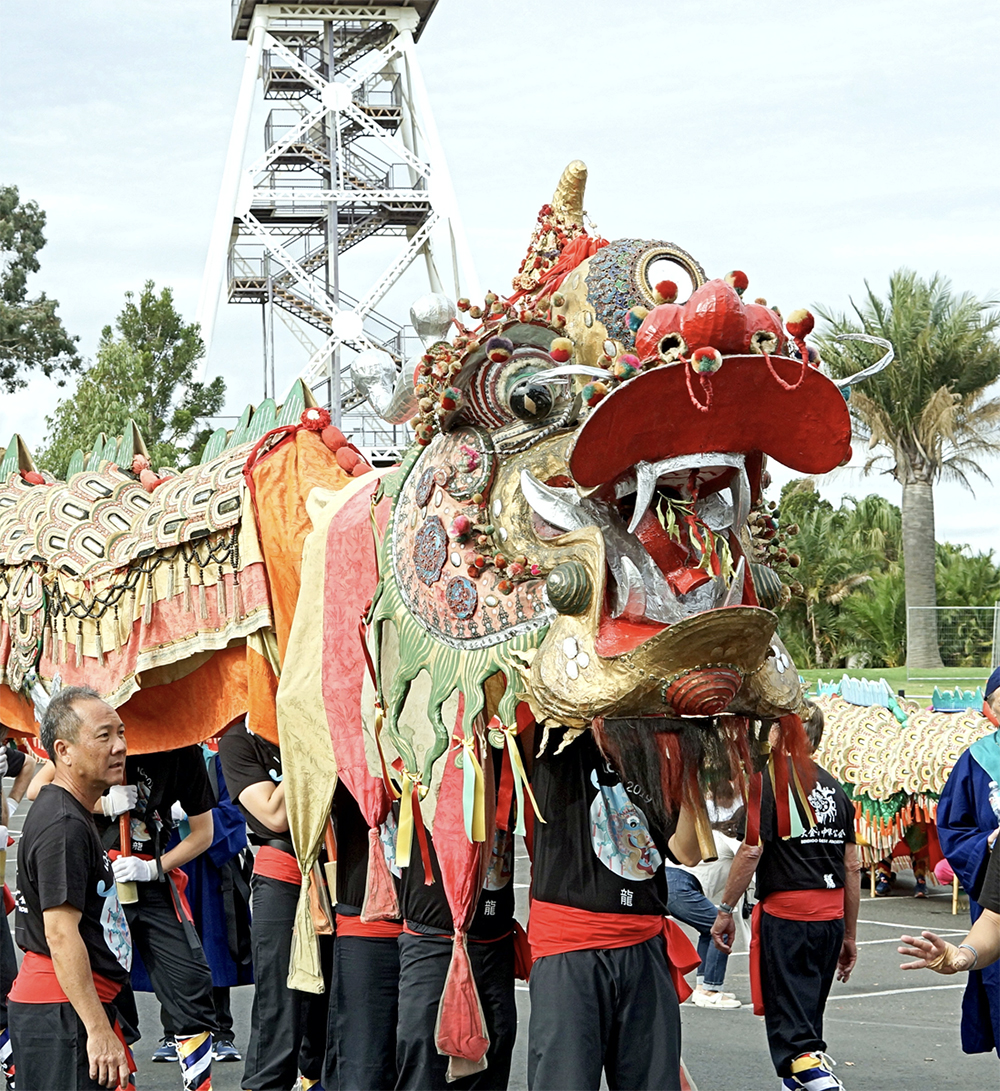
Loong, Bendigo’s oldest dragon, parading at the Easter Festival in 2019 to welcome Dai Gum Loong, the newest dragon to join the unbroken history of processional dragons in Bendigo.
Although trade links between China and Australia pre-date British colonisation, Chinese only began arriving and settling in Australia in large numbers from the 1850s goldrushes. They become the largest non-British immigrant group in Australia at this time. Popularised pseudo-scientific ideas about race and racial hierarchies shaped how these Chinese arrivals were treated. This in turn drove Government legislative responses to Chinese immigration. This legislation was adapted to control all non-white immigration as part of the White Australia Policy. While the White Australia Policy has been dismantled, the repercussions of this period of our history continue to reverberate through Australian society and to shape Australia’s relations with Asia. With a sizable ethnically Chinese population and the rise of the People’s Republic of China as a global power, understanding Australia’s Chinese history continues to be highly relevant today.
Despite the significant role of Chinese during the goldrushes and as a part of Australia’s immigration history, until the 1970s and 1980s their role and contributions were largely overlooked in the histories and collections of public institutions. The Golden Dragon Museum was established in part to rectify this. Its construction in Bendigo’s declining Chinese quarter highlights its role telling this local history. The Museum holds a rich and large collection of objects, textiles, photographs, documents and oral histories that relate to the family and community lives of Chinese and their descendants in Bendigo, the wider Victorian goldfields and beyond. The Museum also seeks to foster an appreciation of Chinese arts and culture through its collection.
An important function of the Museum has been to house the Bendigo Chinese community’s growing collection of processional regalia used in the Bendigo Easter Fair since the late nineteenth century. Chinese processions were relatively common in the nineteenth century, but Bendigo’s is the only one to have continued to the present day. The procession draws on nineteenth century Cantonese cultural practices but transforms these into a uniquely contemporary Australian event.
The Golden Dragon Museum and its collection through its association with the annual Bendigo Easter Fair, the Bendigo Chinese Joss House Temple and the historic White Hills and Bendigo cemeteries has a high social and spiritual significance. The Chinese Easter Fair procession is a focal point for Chinese Australian communities nationally and is deeply symbolic of Chinese Australian achievements and endurance. Paying respect to ancestors at the temple and cemeteries personalises this experience.
This spiritual significance is felt beyond Bendigo Chinese families to others in the Bendigo and the wider Victorian goldfields region. Chinese Australians across Australia and international Chinese visitors also feel the power of this symbolism. For overseas visitors, particularly from the People’s Republic of China, the processional regalia is also a reminder of Cantonese social and spiritual practices suppressed and largely lost during the Cultural Revolution. International lion dancing and Cantonese opera troupes visit the collection to connect with this historical cultural legacy.
The collection is rich in research potential. Embedded within the provenance of the collection are the social, familial and business connections that describe Bendigo’s Chinese Australian communities. These networks extend outwards across Australia and internationally to southern Chinese villages, metropolitan centres like Hong Kong and Shanghai and across the Chinese diaspora. The fine-grained local community history captured within the Museum’s collection has high state, national and international significance.
The Museum’s collection of material related to the Bendigo Chinese Association and local lodges of the Yee Hing / Chinese Masonic Society has the potential to greatly enrich our understanding of these organisations and communities locally and internationally. In addition, they help to show how Bendigo shaped the nature of these groups over time. Both organisations had strong ties to other similar Chinese organisations across Australia, in southern China and across the Chinese diaspora. Both played an important role in the nature of Chinese-Australian communities. These collections have high historical significance.
Contained within the collection are items of high artistic or aesthetic value. The Qing-dynasty processional regalia is particularly stunning in its artisanship, quality of fabric and condition but later collections also have high aesthetic value. Social history collections are not predicated on aesthetics but contained within the Chinese Australian social history collection are high quality textiles such as Charles Powell Hodges imperial robes and other textiles, photographs and beautifully decorated documents and objects. Many pieces within the John St Alban collection are impressive in size, artistic design, workmanship, and materials. They provide insight into Qing dynasty Han Chinese and Sino-Mongolian fine and decorative arts.
The provenance of the processional regalia and Chinese Australian history collections is very strong, often linked to particular individuals and businesses and donated to the Museum by descendants or close family friends. This provenance has been enhanced by the extensive research archive, library and the deep local knowledge of staff members. For families researching their family history these collections have powerful spiritual significance in addition to their historical significance.
There are numerous items in the collection that are rare, unusual or uncommon in public collections, but the Museum’s collection is more significant in its entirety than any one particular object. The Qing dynasty processional regalia and even individual items within it have high historic, aesthetic, research, social and spiritual significance on their own but their significance is greatly enhanced by being part of the set of Qing dynasty regalia. It is even further enhanced by being part of a multigenerational collection of regalia that reflects an unbroken and continuing cultural practice that has evolved since at least the 1870s.
Similarly, there are individual items within the Chinese Australian social history collection that are significant in their own right, but the real strength of the collection is the deep insight it provides into the Bendigo Chinese community as a whole. No other single collection in Australia is able to provide the depth of insight into a Chinese community as large as Bendigo’s, in the detail it does, over such an extended time period. A deep understanding of Bendigo’s Chinese community helps us better understand the histories of Chinese communities around Australia and internationally and, through the connections of Chinese Bendigonians, helps us understand Chinese Australian social and business networking and mobility. This gives the Museum’s collections a national significance.
Dr Sophie Couchman
July 2021
金龙博物馆
重要性陈述
尽管早于英国殖民地时期中国和澳大利亚之间已开始了贸易往来,但华人是从19世纪50年代的淘金潮时期才开始大批抵达和定居到澳大利亚的。在那个时期,他们组成了澳大利亚最大的非英国移民群体。当时普及的种族和种族阶层的伪科学观念,影响了这些中国移民抵澳后的待遇。接下来就驱使政府针对中国移民有了立法, 这项立法作为白澳政策的一部分,用于控制所有非白人移民。虽然白澳政策已废除,然而,我们历史上这段时期所造成的影响,仍然在澳大利亚社会中回荡,并影响着亚澳之间的关系。伴随着中华民族的庞大以及中华人民共和国崛起成为世界强国,在当今了解澳大利亚的中国历史依然至关重要。
虽然华人在淘金潮时期以及在澳大利亚的移民历史中都扮演了重要的角色,但是在20世纪70年代和80年代之前,进行历史与收藏的公共机构在很大程度上都忽视了他们的角色和贡献。金龙博物馆的建立,部分初衷是为了纠正这个现象。博物馆落建在本迪戈(Bendigo)已衰落的华人区遗址上,更突显出通过它来讲述本地历史的担当。馆内收藏了大量的物品、纺织品、照片、文件和口述历史记录,这些都与本迪戈以及更广泛的维多利亚金矿等地区的华人及其后代的家庭和社区生活相关。博物馆也希望通过这些收藏品,以提高人民对中国艺术和文化的认识。
博物馆的重要功能之一是收藏自19世纪末期以来,本迪戈华人社团在本迪戈复活节盛会游行中,不断增添的服饰和特别物品。在19世纪中国式的游行相对普遍,而本迪戈是唯一一个将游行传统发扬至今的地区。以19世纪广东的文化习俗为借鉴,本地戈将游行演绎成了独特的澳大利亚现代盛会。
金龙博物馆及其收藏通过与本迪戈一年一度的复活节庆祝活动、本迪戈致公堂以及历史悠久的白山公墓和本迪戈墓地的联系,突显出其高度的社会意义和精神文化意义。中国式的复活节游行形成了全国澳大利亚华人社团的焦点,也深刻象征了澳大利亚华人的成就和耐力。寺庙和墓地为祖先敬拜提供了个性化的体验。
这种精神文化的意义不仅作为本迪戈的华人家庭可以感受得到,而且本迪戈的其他民众以及更广泛的维多利亚金矿区域的人们也能感受到。澳大利亚的华人和国际华人游客也感受到了这种象征的力量。对于国际游客,尤其是中国的游客来说,这些游行服饰也提醒他们在文化大革命期间,广东人的社会和精神活动受到压制以及在很大程度上的消失。国际舞狮表演团和粤剧团来访并参观了展品表示认可这项历史文化遗产。
博物馆的收藏有很大的研究潜力。藏品的出处来自本迪戈澳大利亚华人的社团、家庭和商业网络,这些网络遍及澳大利亚和世界各地,延伸到了中国南方的村庄,和像香港、上海这样的大都会,以及整个华侨体系。博物馆内收藏的有关当地中华工会的历史,其细节丰富且具有很高的省会、国家和国际上的重要意义。
博物馆的藏品中关于本地戈中华工会和义兴(義興)/中国致公党的资料,在加深对这些组织和社会群体在当地和国际上的认识方面极具潜力。除此以外,还有助于显示本迪戈如何随着时间的推移而塑造这些群体的本质。这两个团体都与澳大利亚、中国南方以及华侨社团中的其它类似华人机构有着密切的联系。两者都在澳大利亚华人社团中扮演了重要角色。这些藏品具有相当高的历史性意义。
藏品中包含了具有高度艺术或美学价值的物品。尤其是清朝时期的游行物品,在用料的质地和保存至今的状态上都令人惊叹,当然后期的收藏也具有很高的审美价值。社会历史性的收藏品并非基于美学,但在中澳社会历史性收藏品中也包含了高质量的纺织品,例如查尔斯 · 鲍威尔霍奇斯的帝国长袍以及其他纺织品、照片和装饰精美的文件和物品。约翰 · 圣 奥尔本收藏品中的许多作品,在尺寸、艺术设计、工艺技巧和材质方面都令人印象深刻。这些藏品提供了对清朝汉族和中蒙的美术装饰艺术的洞察。
博物馆拥有丰富的关于游行礼仪服饰和中国澳大利亚历史性藏品的来源,这些来源往往与特定的个人、企业,和由后裔或家族的亲密朋友捐赠给博物馆有关,并通过档案、图书馆的研究以及工作人员对当地知识深入的了解,得到了进一步加强。对于研究家族历史的家庭来说,这些藏品除了具有历史意义,还具有强大的精神意义。
馆藏中的许多物品是罕见、不寻常或不常见的,但博物馆整体收藏的意义比起任何一件特定的物品来说都更为重要。藏品中的清朝游行礼仪服饰,甚至仅是其中的一些个别藏品,都具有很高的历史、美学、研究、社会和精神意义。然而作为清朝服饰整体集群的一部分,这些收藏品的意义就被更为增强了。此外,作为历代的游行服饰收藏的一部分,这些藏品又反映了至少自19世纪70年代以来从未不间断的、持续发展的文化习俗,从而进一步加强了它的意义和价值。
同样,在中澳的社会历史系列收藏中,也有一些个别的物品,就其自身而言意义重大,但这些藏品具有的真正优势在于,提供了对本迪戈华人社团的整体性的深刻理解。在澳大利亚,没有任何其他的收藏能够像本地戈的藏品这样广泛,可以从细节上对华人社团在如此长久的历史跨度内提供深入的了解。对本迪戈华人社团的深入了解有助于我们更好地理解在澳洲以及全球的华人社团的历史,也通过与本迪戈华人的关联,帮助我们了解中澳之间的社会和商业的网络联系和流动性。这些使得博物馆的收藏具有在国家层面的重要意义。
柯素菲 博士
2021年7月
Collection Redevelopment Project
Context
Golden Dragon Museum has a Collection of over 30,000 objects including Imperial Processional Dragons, textiles, metalware, jade, woodware, photographs and original documents. It is the most important holding of Chinese heritage and cultural material in Australia and has significance regionally, nationally and internationally.
The Collection Redevelopment Project focuses significant resources on the care, development and management of the Collection. It has been underway since November 2021 and will be current for two years. The Project is an ambitious undertaking to significantly improve all aspects of the Museum’s Collection management including storage, conservation, documentation, and cataloguing.
The Project is now past its first year, and this Update reports progress and major achievements through this period as well as maps out immediate next steps and some future plans.
Background
A Significance Assessment undertaken by Dr Sophie Couchman in 2021 made several recommendations on the care and development of the Museum’s Collection. These recommendations supported the urgent need for the Museum to employ a Collections Manager to undertake this work.
To achieve this and as a starting point, the Museum’s Chief Executive Officer, Hugo Leschen, developed the Collection Redevelopment Project as a two-year, intensive intervention by a professional Collections Manager into the Collection and all aspects of its care and management.
The Project
With funding from the City of Greater Bendigo and the Helen Macpherson Smith Trust, as well as support from the Museum’s Board, the then Mayor of the City of Greater Bendigo, Cr Dr Jennifer Alden, launched the Collection Development Project on 20 August 2021. Megan Hall was employed as the Collections Manager to deliver the Project and its outcomes from November 2021 – November 2023.
Following are some highlights of the work undertaken by the Collections Manager over the first year of the Project:
- Upgrade and migration of collection management system (EMu) to hosted server.
- Coordinating and undertaking the required object movements for the Upgrade project and resetting the exhibition spaces after the completion of this project.
- Improving exhibition layout and labels.
- Liaising with Grimwade Conservation Services for the Loong Conservation Project
- Installing building-wide continuous environmental monitoring for temperature and humidity.
- Initiating Integrated Pest Management (IPM) protocols to manage pests in the Museum.
- Fostering the La Trobe University collaboration by engaging with Student Engagement support for possible work-integrated learning placements (internships) and volunteering.
- Fostering the University of Melbourne collaboration, particularly with the Grimwade Centre for Cultural Materials Conservation Masters program, through facilitating the following:
- ‘Content in the Field’ intensive subject in July 2022, which involved students undertaking reorganisation work on the Collection Store, Activities Room, and Loong Gallery.
- Minor Thesis in 2022, undertaken by a student, entitled “Caring for Bendigo’s Imperial Processional Dragons: A proposed strategy for living heritage care within an institutional context”. This thesis aimed to bring together cultural traditional practice and contemporary museum standards to propose solutions for the ongoing care of the Museum’s Dragons into the future.
- Possible internship placement for one student in 2023 for a rehousing and cleaning project
- ‘Treatment 2’ subject in early 2023 where a student will undertake a conservation treatment on a GDM collection item as part of their course.
- Volunteer placements for students to undertake work experience while studying.
- Treasures of Dai Gum San exhibition:
- Exhibition preparation, installation and deinstallation.
- Presented a talk titled “Caring for Treasures” as part of the public programming for Treasures of Dai Gum San, hosted by Bendigo Art Gallery.
- Planning and preparation of Dai Gum Loong and Sun Loong during Easter 2022 to store the two Dragons differently, enable safer long-term storage and reduce ongoing damage.
- At the end of the Loong Conservation Project, it was identified that it would be beneficial to both Loong and the visitors viewing him to turn Loong around so that he faced the entrance to the Loong Gallery, and with the appropriate permissions this final move was undertaken. The Collections Manager later coordinated the ‘Content in the Field’ students to assist Bendigo Chinese Association members in moving the altar to a new and more appropriate location at Loong’s head.
- The previously installed wooden blinds on the windows in the Collections Store were replaced with block-out blinds to reduce the amount of light (including UV) coming into that space.
- The Collections Manager has been heavily involved in discussions around the installation of upgraded exhibition lighting underway in the Sun Loong and Loong Galleries to ensure they meet museum standards and are appropriate for the Collection.
- The Museums Accreditation Program (MAP) has scheduled the Golden Dragon Museum to be reaccredited in 2024. The Collections Manager should gain access to the portal through 2023 to begin preparations for this process.
- The Collections Manager has begun reviewing existing policies and identifying which of them need to be addressed/renewed. Some highlights of this work include:
- Preparing to update the Collections Policy
- Developing a procedure for considering and accepting donations.
- Developing a guideline for acquisitions that can be shared with the public regarding this donation procedure.
- Developing an ‘Offsite Conservation Form’
- Working on developing a guideline for standardised documentation within EMu, in collaboration with the Research Officer.
- The Collections Manager participated in a Collections Development Workshop in November 2022 with Hugo Leschen, Dr Sophie Couchman and the Museum’s Research Officer, Leigh McKinnon, to discuss all aspects of the Collection. This discussion feeds directly into the work on the updated Collections Policy which will be developed in 2023 in preparation for our reaccreditation with MAP in 2024.
- The Collections Manager has been managing, screening and processing donation offers. This has included training staff and volunteers on the agreed procedure and how to manage ‘cold-drop’ donations at the Front Desk, a practice that will discontinue once better arrangements are in place.
- The Collections Manager met with officers from Australian Museum and Galleries Association (AMaGA) Victoria to discuss possible offerings from AMaGA for 2023, especially professional development opportunities which may be applicable to GDM.
- The Museum have been accepted into the Regional Digitisation Project, run by AMaGA Victoria, which provides regional museums with training on museum standard digitisation skills, with demonstrations that will photograph approximately 100 objects. This will take place in May 2023 with collections staff and some volunteers and will commence the overall digitisation of the Collection.
- During the IT Infrastructure Upgrade project, the Collections Manager assisted with managing cataloguing data for the collected archives and the Library catalogue. This data was held in databases that sat on the server and were incompatible with the new IT system, so the Collections Manager exported the data in preparation for migration into a new system. The Research Officer is currently investigating options for the storage of this data.
- The Collections Manager has been making various purchases to improve Collections care. Conservation material such as this has been specifically funded by the Helen Macpherson Smith Trust grant. Purchases include:
- Unbuffered tissue, foam sheeting, archival boxes and other storage materials
- Plastic sheeting, for hazardous materials, and for pest or disaster management
- Cleaning supplies for the objects, including brushes and solvents
- Pest traps and environmental monitoring dataloggers
- Nitrile gloves
- Some upcoming planned purchases include:
- New shelving for the collection store
- 2x cameras, tripods, and related digitisation equipment
- Vacuum cleaners
- Additional Wi-Fi dataloggers
Future Project Goals and Collection Management at the Museum
The major goals for the remainder of the Project include:
- Complete customisation of EMu
- Initiate a Collection Audit
- Initiate digitisation of the Collection
- Process acquisition backlog
- Develop and prepare an exhibition for the new Temporary Exhibition Space
- Review and redraft policies and procedures relating to the Collection including the Collections Policy
- Improve storage organisation and efficiency
- Prepare for MAP reaccreditation
- Develop a Disaster Management Plan
The success and outcomes of the Collection Management Project to date have been significant. The improvements already achieved in the management of the Museum’s Collection have been many, far-reaching and deeply impactful.
The Collection is the Museum’s most valuable asset, and it is critical that it is cared for, managed and developed to the highest possible standards, now and into the future.
With this in mind, the Museum’s Board has recently committed to making the role of Collections Manager permanent and on-going after the end of the Project.
Golden Dragon Museum thanks the supporters of the Collection Redevelopment Project:
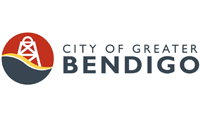
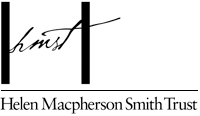
February 2023
Octagonal Lantern, Cloisonne 19th Century
St Alban Collection, Golden Dragon Museum
Loong Conservation Project
Background
Loong is not only a treasure at the Golden Dragon Museum, but he is also recognised as having outstanding heritage value and is included on the Victoria Heritage register. He is unique in the world as the oldest surviving complete processional dragon.
Loong and his regalia form the start of an unbroken chain of three dragons that have been the centerpieces of the Bendigo Easter Festival and Chinese life in the region and across Victoria for over 120 years. Succeeded by Sun Loong in 1970 who was in turn succeeded by Dai Gum Loong in 2019, the Museum’s dragons are wonderful works of art that are deeply embedded in their community where they are still used regularly for cultural and ritual purposes.
Museums are places that store, conserve, research, exhibit and celebrate objects that have special meaning and value to a vast array of audiences. Often the various objects on public exhibition represent only some 5% – 10% or less of a Museum’s total collection. In the case of the Golden Dragon Museum whilst we have many objects on display, they represent only a small percentage of the 30,000 objects in our Collection. To learn more about the Collection and its significance click here.
One of the very important tasks every museum undertakes is the conservation of the various objects in their collection. Be they paintings, statues, wooden, bronze, new or ancient, local or from far away, to ensure that objects remain in excellent condition and do not suffer any more damage or wear and tear than they absolutely must, conservation is a never-ending task. This very technical and delicate work is undertaken by highly trained professionals, Conservators, who work tirelessly most often away from the public view to report, clean, repair, and document museum objects to ensure they can be enjoyed for many years to come.
The project – more details
Starting with detailed condition reporting with many photographs and videos being taken, through to a thorough cleaning literally from head to tail and then painstaking repair work, the Loong Conservation project will see Loong carefully treated using a range of techniques and materials. When finished Loong will be in the best possible condition to stay on exhibition for many years ahead. The project will be current from November 2021 – April 2022.
Given Loong’s size and the complexity of the project being undertaken, much of the work will happen in front of the public when they visit the Museum’s Loong Gallery. Visitors will have the opportunity to speak with the conservators and ask about their work, the project and the project’s progress. From November and into the new year, this will be a very special time to see how these experts work and learn more about what is involved in conserving Loong.
Regular updates on the project will be posted here including monthly newsletters produced by Grimwade Conservation Services.
If you have specific queries or for further information on the project, please email [email protected]
Loong 龍
Loong is the oldest intact processional dragon in the world. He made his first processional appearance in 1901 and was the star attraction of Bendigo’s annual Easter parade until his retirement in 1970. He was created by the Sing Cheung 勝昌 workshop in the city of Foshan (Fatshan) on the Pearl River near Guangzhou (Canton) in southern China. Loong was constructed from silks, mirrors, bamboo, kingfisher feathers, and papier-mache. His name simply means ‘dragon’ but historically he was also referred to by the Chinese community as Gum Loong 金龙 (Golden Dragon) and Moo Loong 舞龍 (Dancing Dragon)
During his parading career Loong made several important appearances outside of Bendigo, most notably at the May 1901 procession in Melbourne to welcome m the Duke and Duchess of York who had come to open the first Australian parliament – a century later he also appeared in the Melbourne parade which marked the centenary of the achievement of Australian Federation. In 2007 Loong was placed on Victoria Heritage register due to his historic and cultural significance. Loong last paraded in the Easter parade of 2019 when he joined Sun Loong 新龍 (new Dragon) and Yar Loong 夜龍 (night Dragon) to welcome Dai Gum Loong 大金龍 (The Great Golden Dragon) to Bendigo.
Loong requires 22 carriers and is 29 meters long. His head weighs 21kg
Project Updates
Project Partners
Golden Dragon Museum is very pleased to be partnering with Grimwade Conservation Services who are based in the Arts Faculty at The University of Melbourne and will be undertaking this project. Recognised internationally for the quality of their work and with many awards and accolades to their credit, Grimwade Conservation Services will be working with local experts, volunteers and students and oversighting the project to ensure that it delivers outstanding results.
Funding of $133,000 has been provided by the Victoria State Government through Heritage Victoria’s Living Heritage Grants Program.
Golden Dragon Museum gratefully acknowledges the generous support of our project partners.

The Loong, Chinese Dragon Conservation project is supported by the Victorian Government through the Living Heritage Grants Program.
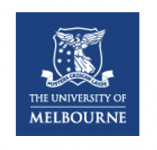
Grimwade Conservation Services, Faculty of Arts, The University of Melbourne, are proud partners in this project.
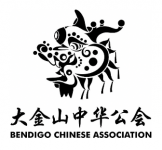
Bendigo Chinese Association has proudly cared for and lovingly owned Loong since 1901. Loong is generously on permanent loan to the Golden Dragon Museum.
Golden Dragon Museum wins major award
At the recent 2022 Victorian Museums and Galleries Awards Golden Dragon Museum won The Archival Survival Award: Small organisations for Loong Conservation Project.
The Awards are the peak state-wide awards for museums and galleries and recognise excellence across various categories.
The Loong Conservation Project lasted 12-months and saw Loong conserved to the highest possible standards by conservators from Grimwade Conservation Services (GCS), BCA and other volunteers and University of Melbourne students.
The project was supported by the Victorian Government through the Living Heritage Grants Program, Heritage Victoria, and the University of Melbourne’s Centre for Contemporary Chinese Studies. The conservation project team (conservators and volunteers) delivered 2375 hours of treatment work to a rare and culturally significant processional dragon on permanent display at the Golden Dragon Museum. This conservation project ensures Loong can be enjoyed, researched, used culturally, and exhibited for decades ahead.
Judges’ comments “The judges praised Golden Dragon Museum for a “great project making the process of cultural materials conservation visible to the public, particularly when it can be a very time consuming and delicate operation. Wonderfully engaging”.
The Museum is proud to win this award from a very strong group of finalists and thanks all our Project Partners for their unstinting support and enthusiasm.
Loong Conservation Project wins national award
The team of conservators who worked tirelessly throughout the Loong Conservation Project, led by Grimwade Conservation Services, has won the Australian Institute for the Conservation of Cultural Material’s award for Outstanding Conservation Treatment of the Year 2022, for their outstanding efforts throughout this project. Recognised as the pre-emanant acknowledgement of excellence in conservation throughout Australia, the Award showcases the care, professionalism, diligence and expertise of the team of 18 conservators who worked on Loong throughout the Project.
The Loong Conservation Project was supported by the Victorian Government through the Living Heritage Grant program.
